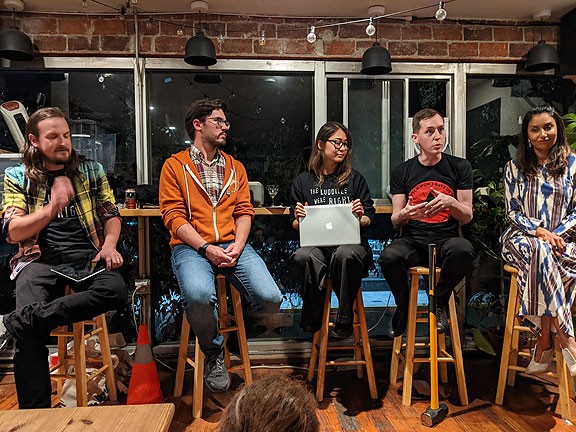
The Luddite Tribunal held at Oakland’s Tamarack Cafe on November 9, 2023. (l to r) Brian Merchant, Safe Street Rebel, Wendy Liu, Paris Marx, and Veena Dubal.
I’ve been called “Luddite” from time to time, though I have always refused the category of “technology” as having any particularly useful reference point. Criticizing technology, or more to the point, a particular way of organizing work, of organizing activities that exploit nature in more or less dramatic ways, leads quickly to isolation and to questions about one’s sanity. It is quite unusual to suggest that the “techno-sphere” we assemble together should be subject to democratic decision-making. The ideological system that relegates such concerns to the margins, and insists that the only people capable and worthy of addressing what technologies we should adopt, how work should be organized, what our relationship to nature ought to be, are those with the capital—and the commitment to profit as the motivating principle—was invented at a specific historic moment. The power of capitalists was dramatically seized at the expense of the earliest organized working-class critics of automation: derisively and falsely “remembered” as the Luddites.
This matters now because over the past few decades anyone who objected to the rise of Amazon, Google, Facebook, Apple, or any of a number of other massive companies, are generally dismissed as “luddites” standing in the way of inevitable progress. There has been two centuries of refining this line of argument, starting at its point of origin among the textile workers in England at the beginning of the 1800s, the ones who broke into the new factories to wreck various machines they saw as destroying their ability to live from the work they did. Their movement of organized property destruction, alongside efforts to establish rights for workers to shape the introduction of new machinery and new ways of organizing work, was brutally suppressed by extensive state violence, including the wide use of capital punishment for anyone associated with this movement.

Brian Merchant (left), Veena Dubal after she smashed an iPhone, and Paris Marx clapping behind.
Brian Merchant has recently published an excellent history of the Luddites, the protagonists of the original revolt against technology, which Merchant makes clear was not so much a revolt against technology as a refusal to lay down and die before the unrestrained power of the owners of capital. His book, called Blood in the Machine: The Origins of the Rebellion Against Big Tech (links to this and the other eight books I mention are listed at the end), presents a very well-written, compelling, detailed account of the social conflict that erupted in England at the beginning of the 19th century, pitting the earliest “start-up founders” against a wide range of workers, starting with the textile workers who saw their skills being mechanized, and their work being degraded as they were forced into the new-fangled factories that the most rapacious entrepreneurs of the period insisted would be the new way to work.
Artisans, hatmakers, shoemakers, bricklayers, small shop owners, and farmers joined the cause. So did coal miners and railroad workers, whose industries were on the rise due in part to the technology and automation—because the Luddite movement was not about technology; it was about workers’ rights. Luddism started as a tactical strike against the technologies of control, but had exploded into a greater expression of the rage against a system where the privileged few with access to the right levers could lift themselves up at the expense of the many. (p. 143)
The real Luddite movement was, of course, multifaceted, complex, and driven by a range of grievances and demands. The Luddites as most of us know them, moronic machine smashers, are in fact inventions. They’re the myth invented by their critics, not the well-organized, strategic, and morally empowered force that contested the rise of the factory and the entrepreneurial manager in the 1810s. (p. 305) … Entrepreneurs, factory operators, and executives have been chasing that fantasy ever since. In the twenty-first century, Amazon touts plans for fully automated warehouses, high-tech companies aspire to “dark” factories—factories emptied of humans and automated to such an extent that they can be run without the lights on—and robotics and enterprise software firms pitch a battery of automation services and products to clients afraid of being left behind. Now, as then, we’re made to believe that we are in an uncomfortable but necessary transitional period, right before technology will inevitably solve all our woes. (p. 320) … Ever since the Luddites, wage-earning workers have been, in one form or another, at the whims of an overseer who deploys technology to control the division of labor. That, above all, is what entrepreneurs and the state won, when the Luddites lost. (p. 321)
I appreciated Merchant’s willingness to break into his historic narrative at numerous points along the way to underscore the contemporary manifestations of the same kinds of struggles. Rather than leaving us with the impression that the Luddites were some kind of primitive, pre-modern people who were merely lashing out at life changing under their feet, we instead come to understand that the conflict they fought is a conflict we’re still fighting. The harsh brutality of workplace conditions in an Amazon warehouse is just a contemporary example of the vicious and violent regime created in the factories that were the founding institutions of the early Industrial Revolution.
It wasn’t just a lack of Covid safety, or even worker safety, per se. It was the combination of punishing conditions, lack of benefits, constant surveillance, and stagnant pay. It was breaking your back to keep up with the robots while the man who owned the operation broke records for making so many billions of dollars. The man who is, if he is not already, on his way to becoming the biggest factory boss in history—Jeff Bezos. (p. 379) … This relentless, technologically dictated pace of work is ultimately driven, just as it was in the Luddite days, by an entrepreneur exercising a more audacious will to profit than anyone else, and an openness to implementing systems that others might deem too inhumane, in order to realize those profits. (p. 380)
In another pandemic book, Alessandro Delfanti dives deeply into the modern labor process in Amazon warehouses (The Warehouse: Workers and Robots at Amazon). As an Italian he has roots in the bottom-up analyses of workers research organizing pioneered by radical Italian workers decades ago. He talks to workers not just in the U.S. but also Amazon workers in Piacenza, Italy, an area where “fulfillment centers” for many modern corporations are situated to serve the Italian and European markets. He comes to intimately understand the dehumanizing banality of the structure of work there:
Apparently, Jeff Bezos believes that a stable workforce can cause a “march to mediocrity,” and thus that turnover must be incentivized to minimize the presence of workers who become too comfortable or disgruntled. As reported by Amazon insiders, he thinks that all workers are inherently indolent and that their performance naturally decreases over time. (p. 95) … Often, though, quitting leads to more atomization. Even when it is beneficial for the individual worker, this individual form of refusal does not bring about collective power. Actually, high turnover rates represent a concrete barrier to organizing, as many disgruntled workers quit instead of fighting within Amazon. … Workers in Piacenza, like those in many similar areas where Amazon has a fulfillment center, may have more opportunities, but many of those other opportunities will be for a very similar job, just in another company’s warehouse, be it IKEA, TNT, or Zalando. Finally, quitting may play into Amazon’s hands, since the company does not exactly shy away from worker turnover. Rather it treats it as a core feature of its business model, going so far as to engender planned employee obsolescence. The company is perfectly fine with people leaving in droves, so long as a reserve army of new workers is available to replace them. In the long run, it is planning to introduce automation that reduces its dependence on human labor—although it may never be able to do away with it. Unless it is politicized and generalized, refusal of work will remain a self-preserving strategy but won’t make a dent in Amazon’s power. (p. 152)
The current division of labor, the role of automation and technology, the long-term decline of unions and organized labor in the U.S. and Europe, has its roots in a seminal moment in San Francisco history. The ILWU, the Longshore and Warehouse union, made an historic agreement in 1960 called the Mechanization & Modernization Agreement (M&M). A bitter fight inside the union preceded the agreement, with the left-leaning members opposing it and the supporters of union leader Harry Bridges ultimately prevailing in favor of it. The role of Harry Bridges and the ILWU is one still lauded by the remnants of the Left but it is a misguided understanding of how crucial the “M&M” was to the evolution of class relations globally in the mid-20th century. A new biography of Harry Bridges by Bob Cherny (Harry Bridges: Labor Radical, Labor Legend), carefully documents Bridges’ long and complicated political, personal, and union life. During the 1971 ILWU strike, which was halted when President Nixon invoked the Taft-Hartley Act to force a 60-day cooling off period, Cherny concludes that Bridges, who had been publicly criticizing his own rank-and-file members for striking, had become averse to rank-and-file militancy, so the onetime defiant strike leader had also become reluctant to strike.” (p. 318) But it was in his embrace of the 1960 M&M that Bridges had earned his new-found reputation as a “labor statesman,” and found himself lauded by the proponents of automation and globalization.
As Bridges was facing retirement, A.H. Raskin, longtime and highly respected labor reporter and assistant editor of the New York Times, lauded Bridges as “a pattern-setter in a cooperative approach to waterfront automation that reversed the century-old tradition of Luddite resistance by labor generally to technological change.” And, Raskin declared, the M&M “pushed other unions into similar accommodations, thus heightening the efficiency of American industry and strengthening its global competitiveness.” (p. 340-341)
According to Herb Mills, much of what was lost after the M&M was a culture that had evolved during the 25-year “golden era” of longshoring (apx. 1935-1960). That culture not only allowed for intense political and philosophical debate on the job and provided an institution for self-managing the allocation of work (the Hiring Hall), it was also a work culture of conviviality and solidarity.

Clipicide, or Death of a Time Thief… an installation I did with Marina Lazzara at stage right during a play at the Victoria Theater in the early 1990s.
Pasquinelli goes into the deep history of science and technology in AI in his new book The Eye of the Master: A Social History of Artificial Intelligence, and we find a similar focus on the human relationships that are the real basis of new ideas, new ways of doing things, and that ultimately become embedded in machinery established primarily “to achieve a more accurate calculation and extraction of surplus value.”
The epistemic imperialism of science institutions has obfuscated the role that labour, craftsmanship, experiments, and spontaneous forms of knowledge have played in technological change: it is still largely believed that only the application of science to industry can invent new technologies and prompt economic growth, while this is in fact rarely the case. (p. 84) … For instance, Edgar Zilsel, a historian of science, documented how even the ‘heroes’ of the so-called Scientific Revolution, such as Galileo Galilei, learned more in clandestine workshops, hidden libraries, and nomadic classrooms than at universities.(29) … Rather than cultivating the provincial ‘heroism’ of craftsmen in a reactionary way, the image of the ‘mindful hand’ stresses the convivial dimension of experimental life and its inventions. (p. 90)
It is from the materiality of collective labour, from conscious and unconscious forms of cooperation, that extended apparatuses of machines emerge. Here, intelligence resides in the ramifications of human cooperation rather than in individual mental labour. Machine intelligence mirrors, embodies, and amplifies the analytical intelligence of collective labour. (p. 107) … Rather than a knowledge theory of labour that grants primacy to conscious activity… Marx maintains a labour theory of knowledge that recognises the cognitive import of forms of labour that are social, distributed, spontaneous, and unconscious. Intelligence emerges from the abstract assemblage of workers’ simple gestures and microdecisions, even and especially those which are unconscious. (p. 119)
I wrote about this in Nowtopia, quoting from Patricia Smith’s wonderful book The Body of the Artisan, which similarly argued that knowledge arose among early tinkerers, mechanics, and workers who by engaging in various types of practical work, learned to “read the book of nature,” and to draw conclusions from their own observations. This framing turns histories of “great men,” of genius inventors (sometimes female), on its head. Instead of identifying certain individuals as extraordinary minds who made breakthroughs, the vast majority of human knowledge, scientifically verified as the methods of science evolved, arises from practical activities of artisans, tinkerers, mechanics, farmers, etc. That some people, like Galileo or Francis Bacon, have been exalted as geniuses fails to see the social milieu in which they operated, how their intellectual breakthroughs depended on relationships with countless anonymous people whose everyday activities were the real source of the evolving knowledge of life. As we flash forward to our current era, there are many ways we have lost the thread, forgotten or never understood the prosaic relationships of embodied work that are the driving force of technological change over centuries.
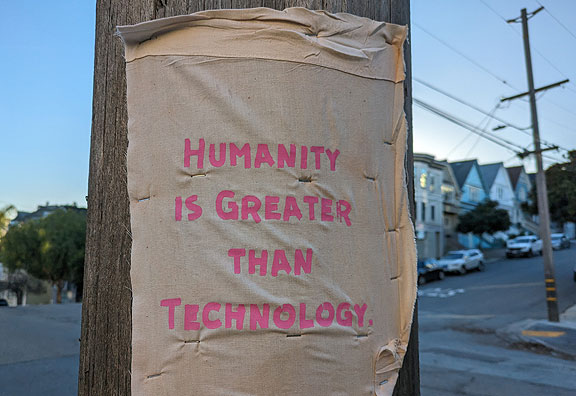
Random telephone poll with a message!
San Francisco is strongly identified as a tech capital given its proximity to Silicon Valley and the enormous pools of venture capital that slosh around the greater Bay Area looking for the next google or facebook or uber. My history project, Shaping San Francisco, got its start in the mid-1990s when an earlier tech boom (“Web -1”) was promising a future of “interactive multimedia” that would absorb all other media forms and deliver news and entertainment on CD-ROMs! Going back even longer there was a distinct “tech boom” associated with the Gold Rush and the rapid developments in metallurgy and metal work that made possible the incredibly destructive decades of hydraulic mining that washed the equivalent of eight Panama Canals of rock and soil from the Sierra Nevada into Northern California rivers and eventually the San Francisco Bay.
Our most recent boomlet is the much-hyped arrival of so-called “AI or artificial intelligence,” leading to the rechristening by the New York Times of the Hayes Valley neighborhood as “Cerebral Valley.” Sheesh! Considering how few people are actually involved in producing this new software, it seems that local promoters pushing so hard on the AI wagon are desperately trying to convince themselves that another spin around the get-rich-quick merry-go-round is imminent. And it may be that ChatGPT and its ilk will be widely adopted, either as search engines, digital assistants, or replacements for a whole range of writers, artists, and others who have survived by generating the vast flood of empty content filling the internet and beyond. But as Matteo Pasquinelli ably demonstrates “… the fear that AI fully replaces jobs is misguided: in the so-called platform economy, in reality, algorithms replace management and multiply precarious jobs.” (p. 250)
And who wants precarious jobs? In fact, who wants to work at all? Sarah Jaffe published Work Won’t Love You Back in 2021, and like many books published during the pandemic, it probably didn’t get the attention it deserves. Jaffe is a labor journalist and can be heard on her podcast Belabored which covers all sorts of worker organizing and strikes and fills a serious void that has been left by the elimination of labor reporting nearly everywhere except labor’s own press. Her book takes on the insulting refrain heard all too often during the 21st century to “do what you love.” It’s been ten years since I wrote about Miya Tokumitsu’s take-down of this ridiculous slogan, but a decade on, it still shapes all too many people’s expectations of what they could or ought to find when they trade their time for money. Jaffe is as clear about this as you can be:
Exploitation is not merely extra-bad work, or a job you particularly dislike. These are the delusions foisted on us by the labor-of-love myth. Exploitation is wage labor under capitalism, where the work you put in produces more value than the wages you are paid are worth. Exploitation is the process by which someone else profits from your labor. This is true whether you’re a nanny making $10 an hour, allowing your employer to make much more money at her higher-paid job, or a programmer at Google making $200,000 a year while Google rakes in over $7 billion. (p. 17)
Jenny Odell, in her excellent Saving Time: Discovering a Life Beyond Productivity Culture, embarks on a wide-ranging examination of how time itself evolved, and what kinds of power is hidden inside its apparent objectivity:
The wage relationship, in turn, reflects those same patterns of empowerment and disempowerment that touch everything else in our lives: Who buys whose time? Whose time is worth how much? Whose schedule is expected to conform to whose, and whose time is considered disposable? These are not individual questions, but cultural, historical ones, and there are few ways to liberate your time or anyone else’s without considering them. (p. xiv)
In my early life, the conflict over work and our time was still an active issue. The social movements of the 1960s and 1970s directed a great deal of their critical energy towards reimagining work and the kind of society we were producing. Sarah Jaffe again:
The difference between what the movements of the 1970s wanted and what they got was telling. They wanted democratic control over the firm; they got employee stock ownership plans. They wanted less work, a life less dominated by demands of the boss; they got fewer jobs and work fragmented into gigs. They wanted less hierarchical trade unions; they got union-busting. They wanted freedom for creative pursuits; they got, in Fisher’s terms, “managerialism and shopping.” They wanted to change their relationship to the patriarchal nuclear family; they got admonitions to see coworkers as family and the need to be constantly networking. They wanted more interesting work; they got simply more work. The wanted authentic human connection; they got demands to love their jobs. (p. 16)
A similar point is made by historian Jefferson Cowie in his book about the New Deal, The Great Exception:
The 1960s countercultural challenge to American norms dissolved into some of the nation’s most vaunted mainstream traits: consumption, religious revivalism, and anti-statism. The Dionysian outlook readily melded with materialism and libertarianism, while America’s consumer culture easily absorbed the 1960s’ more commercially viable trends. (p. 194)
Political movements of the 1960s and 1970s fell short in their drive for autonomy and freedom from the dictates of capitalist work. Pasquinelli draws out the relationship between that kind of social energy at the base of society and the emergence of specific technologies that mirror and try to capture those socially driven priorities (and ultimately turn them against themselves).
Information algorithms were designed according to the logic of self-organisation to better capture a social and economic field undergoing radical transformation.(p. 155) … In hindsight, both cybernetics and the post-war social movements were directly related to the autonomisation of knowledge and information in labour processes and social behaviours, which had triggered the rise of new media and technologies. (p. 159) … The destiny of the automation of intelligence cannot be seen as separate from the political drive to autonomy: it was ultimately the self-organisation of the social mind that gave form and momentum to the project of AI. (p. 160) … For the way in which they have been built on large repositories of cultural heritage, collective knowledge, and social data, large foundation models are the closest approximation of the mechanisation of the ‘general intellect’ which was envisioned in the industrial age. (p. 248)
The idea of the General Intellect re-emerged in the past half century of autonomous working-class organizing, starting with Italian theorists in the 1960s. I used it in Nowtopia to discuss what I saw as a fight over the direction of the “general intellect.” When people took their time and technological know-how out of the market, doing projects for many other reasons than making money, they were nearly always involved in repurposing technologies and often challenging the direction of the techno-sphere as laid out by capital. Whether the wide opposition in California to aerial spraying to eradicate a medfly infestation, or opposition to nuclear power plants, or simply embracing the bicycle and retrieving hundreds from the waste stream of modern consumerism, I argued that a new kind working class politics was openly contesting the direction of science and technology. Self-taught experts could take on the corporate and government officials who claimed that pesticides and radiation were harmless. Others rejected the ball-and-chain of car ownership in favor of a self-liberating urban life based on the greater mobility and improved mental and physical health provided by the simplest transportation technology beyond walking, the bicycle. And so on.
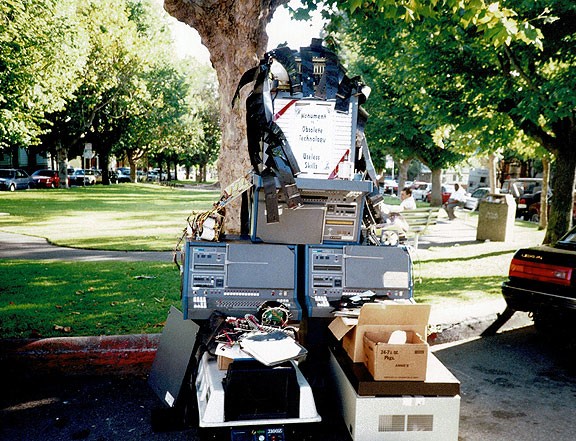
My own moment of technological obsolescence: 1994 we piled up our useless phototypesetting machines and fonts and chemical processor and hung a sign on it saying “Monument to Obsolete Technology and Passing Skills”… in South Park, later “Multimedia Gulch!”
Since I published that argument in 2008, of course, things haven’t gone quite as I predicted! Instead, we have seen the emergence of social media and its vast apparatus dedicated to capturing human behavior and monetizing it in countless ways. We’ve seen the taxi industry reduced to ruins by the lawbreaking arrival of Uber and Lyft and their machinations to drive their pre-existing competition out of business all while radically worsening the conditions for the humans who drive the cars.
And since a year ago San Francisco has been overrun by robo-taxis, the so-called self-driving autonomous vehicles that are meant to take the logic of Uber to the next level and eliminate humans altogether. But of course they cannot. General Motors’ version called Cruise has already come and gone, crashing (literally) and burning through millions of dollars in a very short time. Google’s Waymo is still ominously rolling through the streets of San Francisco, but usually empty. My partner took one once at the instigation of a friend who had worked for them. She rode home from downtown to the Mission and reported it was the worst car ride she’d ever had, at least 15 minutes slower than a normal car would have been since the Waymo is currently programmed to stop everywhere very deliberately, proceed very cautiously within formal speed limits, etc. None of that makes for an expeditious ride across town.
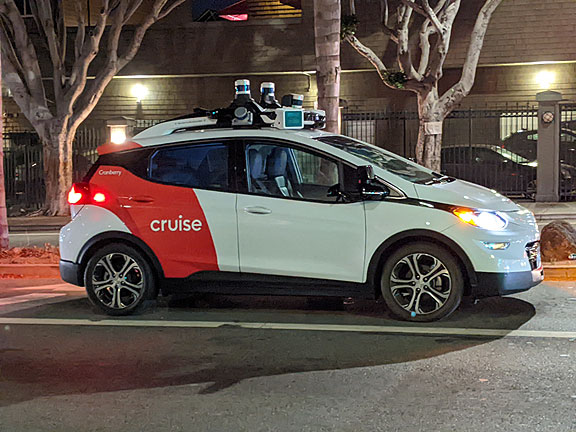
A General Motors autonomous vehicle, or robo-taxi, rolling through the Mission. They are thankfully off our streets now.
The bizarre politics and economics of autonomous vehicles is taken up by two excellent books, Paris Marx’s Road to Nowhere: What Silicon Valley Gets Wrong About the Future of Transportation, and Peter Norton’s deeper history Autonorama: The Illusory Promise of High-Tech Driving. Paris Marx states the basic truth about halfway through his book:
The problems that autonomous vehicles claim to solve—traffic congestion and road safety foremost among them—can be effectively addressed through low-tech means, but that will require engaging with the politics of transportation and the distribution of benefits and harms that arise from both the existing system and the proposals for the future. Part of Silicon Valley’s promise is that its solutions are apolitical and do not involve digging into these difficult political questions, even though the seemingly apolitical nature of autonomous vehicles hides how they maintain and reinforce the existing unequal dynamics that already define transportation networks. In short, their promise is a lie. (p. 132)
Peter Norton, who earlier wrote the excellent history of “motordom” called Fighting Traffic, shows how the hype around autonomous vehicles is not only false, but it’s also surprisingly old. He argues that the promotional blather we’re hearing now was first laid out almost a century ago by the burgeoning automobile industries in the 1920s. He rolls through the Futurama built at the 1939 World’s Fair in New York, a later version in the 1964 World’s Fair, and then shows how motordom has relied on a 20-year “future” that never comes to hype its latest line of cars. Moreover, the promises of safe, speedy autonomous vehicles is self-contradictory. The faster they go, the more risks they take, the quicker they get you to where you’re going, the more accidents they will cause. It’s a simple formula.
As a matter of business necessity, AVs must be programmed to take chances. In a messy real world, AVs cannot have 100 percent confidence, or even just always err on the side of caution. There can be no market for vehicles that often make unexpected sharp turns or that hard-brake every few seconds or minutes. (p. 152) … The twentieth century should have taught us that accommodation of expensive transport does not merely neglect affordable mobility; it actively degrades it. Similarly, it should have taught us what Charles Kettering already understood in 1929; that transport consumerism is uninterested in satisfying consumers’ mobility needs; it wants to promote consumption by “keeping the consumer dissatisfied.” (p. 180) … It would be easy to dismiss all four futuramas as mere marketing, a form of promise making that no one should take seriously. But in investment circles, in engineering research, and in policy forums, the futuramas’ essential premises have been governing principles. They take car dependency as a given, not as an option. (p. 141)
As I am wont to do in these blog posts, I’ll end with a sequence of further quotes from the books I’ve been talking with and about here. Jenny Odell helpfully reminds us that any understanding of where we’re heading is necessarily connected to where we’ve been:
To look into the future is to look around; to look around is to look into history—at not the apocalypse coming but the apocalypse past, the apocalypse still unfolding… The current meaning of apocalypse is modern; in Middle English it simply meant “vision,” “insight,” or even “hallucination.” The world is ending—but which world? Consider that many worlds have ended, just as many worlds have been born and are about to be born. (p. 187)
Brian Merchant sums up the problem as the autocratic control of technological development:
The biggest reason that the last two hundred years have seen a series of conflicts between the employers who deploy technology and workers forced to navigate that technology is that we are still subject to what is, ultimately, a profoundly undemocratic means of developing, introducing, and integrating technology into society. Individual entrepreneurs and large corporations and next-wave Frankensteins are allowed, even encouraged, to dictate the terms of that deployment, with the profit motive as their guide. Venture capital may be the radical apotheosis of this mode of technological development, capable as it is of funneling enormous sums of money into tech companies that can decide how they would like to build and unleash the products and services that shape society. (p. 410)
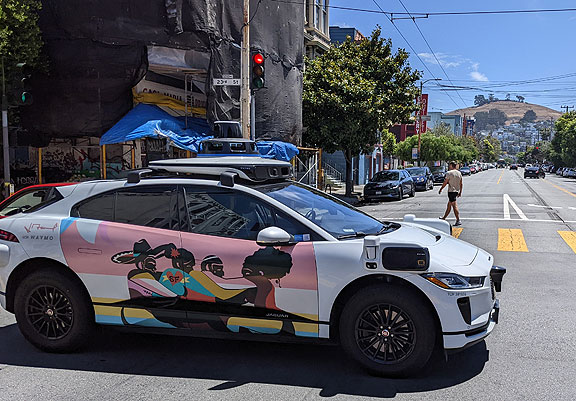
An empty Google Waymo robotaxi in the Mission.
Peter Norton takes down every part of the ridiculous logic promoted by motordom for the past century up to the present hype around self-driving cars. But in the end he strikes a note that escapes being dismissed as simple “Luddism:” “Technology can solve no human problem for us, but humans with technology can solve problems for ourselves.” (p. 187)
Matteo Pasquinelli, having gone through an incredibly detailed dissection of the history of “artificial intelligence,” (and reassuring us that since the technology is basically a game of statistical correlations at a very large scale, and given the computational constraints that are rarely admitted publicly, “current AI runs no risk of becoming a malevolent ‘superintelligence’”) concludes by pointing to a different way of thinking about technological development going forward:
What is needed is neither techno-solutionism nor techno-pauperism, but instead a culture of invention, design and planning which cares for communities and the collective, and never entirely relinquishes agency and intelligence to automation. The first step of technopolitics is not technological but political. It is about emancipating and decolonising, when not abolishing as a whole, the organisation of labour and social relations on which complex technical systems, industrial robots, and social algorithms are based – specifically their inbuilt wage system, property rights, and identity politics. New technologies for labour and society can only be based on this political transformation. It is clear that this process unfolds also by developing not only technical but also political knowledge… In confronting the epistemology of AI and its regime of knowledge extractivism, a different technical mentality, a collective ‘counter-intelligence’, has to be learned. (p. 253)
I think this is similar to what I was calling for in Nowtopia, and perhaps have been calling for since the beginnings of Processed World magazine in 1981. Neither a politics of simple refusal, nor any blind enthusiasm for the products of a system based on our exploitation and degradation. Somewhere ahead of us, rooted in the histories that led us here, is a new social politics that facilitates a democratic process of deciding together what we want to do and how to do it. Some of that will involve the use of machines and digital technologies, but in ways we cannot yet know, and on terms we have not yet set. And as I tried to allude to in my new novel, we probably won’t be the only deciders—nature itself has a major role to play, and its will, its agency, remains opaque to us now. Perhaps that is part of what our ability to properly engage with the techno-sphere will entail—a new engagement with the natural world in which everything we are and do occurs.
Autonorama: The Illusory Promise of High-Tech Driving
by Peter Norton, Island Press: 2021
Blood in the Machine: The Origins of the Rebellion Against Big Tech
by Brian Merchant, Little, Brown and Co., 2023
The Eye of the Master: A Social History of Artificial Intelligence
by Matteo Pasquinelli, Verso Books: 2023
The Great Exception: The New Deal & The Limits of American Politics
by Jefferson Cowie, Princeton University Press: 2016
Harry Bridges: Labor Radical, Labor Legend
by Robert W. Cherny, University of Illinois Press: 2023
Road to Nowhere: What Silicon Valley Gets Wrong About the Future of Transportation
by Paris Marx, Verso Books, 2022
Saving Time: Discovering a Life Beyond the Clock
by Jenny Odell, Random House: 2023
The Warehouse: Workers and Robots at Amazon
by Alessandro Delfanti, Pluto Press: 2021
Work Won’t Love You Back: How Devotion to our Jobs Keeps Us Exploited, Exhausted, and Alone
by Sarah Jaffe, Bold Type Books/Hachette Book Group: 2021

Had a fun chat with Peter Maravelis online about my new novel When Shells Crumble which is now posted to the City Lights Youtube channel.












A fairly awesome essay, with really wide-ranging and penetrating quotes. Who else writes such well-researched and highly pertinent freely available essays?
However, and this is my habitual “however,” the negative side of these issues is pushed to the side. For instance, P.K. Haff, in this paper,
https://pne.people.si.umich.edu/PDF/Haff%202013%20Technology%20as%20a%20Geological%20Phenomenon.pdf
posits the “technosphere” as hegemomic, uncontrollable, insatiable in its demands. The general intellect is simply grist for the technosphere’s mill, which Luddism attempts to ignore.
As Sarah Jaffe’s brilliant quote suggests, “movements” that resulted in the opposite of their aims are not to be bathed in a golden hue, but lamented in a proper burial. My job, from which I am happily retired, was stupid, brutal, and pointless, and for those reasons I loved it for its appropriateness.
Hey, how come the AI captcha bullshit features a bicycle?
always good to hear what you are up to / love your insights mixed with historical work experience / hope you post more frequently in 2024 / love you man / peace